Minolta
 From Nwe
From Nwe | Minolta XD-7 (XD-11, XD) | |
|---|---|
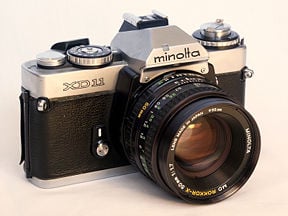 |
|
| Type | 35 mm SLR |
| Lens mount | Minolta MD mount |
| Focus | Manual focus |
| Exposure | Shutter and Aperture priority autoexposure |
| Flash | Hot shoe only |
| Dimensions | 51 x 86 x 136 mm, 560 g |
Minolta Co., Ltd. was a Japanese worldwide manufacturer of cameras, camera accessories, photo-copiers, fax machines and laser printers from 1933 until 2003, when it merged with Konica Corporation to form Konica Minolta. Minolta was founded November 11, 1928, in Osaka, Japan, as Nichi-Doku Shashinki Shōten (日独写真機商店; Japanese-German camera shop) by Kazuo Tashima (1900 – 1985), in collaboration with two German engineers. The name Minolta was registered in 1933, and first appeared the same year on a camera, a copy of the Plaubel Makina simply called "Minolta."
Kazuo Tashima's objective was to produce affordable cameras that allowed amateurs without much skill or experience to take professional-quality photos. During times of financial difficulty, he refused to become a subsidiary of more established companies, and persistently pursued this ideal, developing a series of ground-breaking inventions. Minolta is perhaps best known for making the first integrated autofocus 35 mm SLR camera system. From the late 1950s through the 1980s, Minolta introduced one innovation after another; it was the first Japanese manufacturer to introduce a bayonet lens mount rather than a screw mount, the first manufacturer to introduce TTL metering with full aperture, and the first manufacturer to introduce multi-mode metering. Its Maxxum series was the first commercially successful autofocus SLR line. In 2006, Konica Minolta announced the sale of its digital camera business to Sony, and ceased the production of film cameras, to become solely a manufacturer of office machines.
History
Early days
Nichidoku Shashinki Shōten (日独写真機商店, “Japan-German Camera Store”), the precursor of Minolta, was founded in Osaka on November 11, 1928[1] by Kazuo Tashima (1900 – 1985), who had a fascination with optical equipment and cameras, which were rare in Japan at that time. Tashima enlisted the support of two German camera technicians, Billy Neumann, who had previously worked for Krauss in Paris, and Willy Heilemann who had worked for Kenngott; the first cameras used lenses and shutters imported from Germany. A plant was built in Mukogawa (武庫川), in the prefecture of Hyōgo (兵庫県).[2]
The first camera produced by the company was the Nifcarette, released in 1929. It was followed by the Nifcaklapp and Nifcasport folding cameras and by the Nifca-Dox strut-folder, all taking film plates or pack film. At this early period, all the cameras were directly advertised and distributed by the company, which was using a round logo with the letters N, D, PH and Co assembled inside a circle.[3]
In 1931 the company was reorganized as a joint-stock corporation named Molta Gōshi-gaisha (モルタ合資会社), taken from the German "Mechanismus Optik und Linsen von Tashima" ("Mechanism, Optics and Lenses by Tashima").[4] The mention of Germany disappeared from the company name, and Heilemann and Neumann left the company respectively in November 1931 and in 1932, to found their own Neumann & Heilemann company. The camera range was also renamed: the Nifcarette became the Sirius Bebe, the Nifcaklapp became the Sirius, and the Nifcasport became the Arcadia. The cameras were still distributed by the company itself for a couple of years, and the Sirius and Arcadia were also distributed by Misuzu Shōkai as the Lomax and Eaton. Molta later entered an agreement with the Tokyo-based distributor Asanuma Shōkai, which distributed the cameras and assumed all the advertising until 1945, and retained commercial contacts after the war. The Sirius and Arcadia plate cameras were replaced by the Asanuma brand Happy.[5]
Early cameras
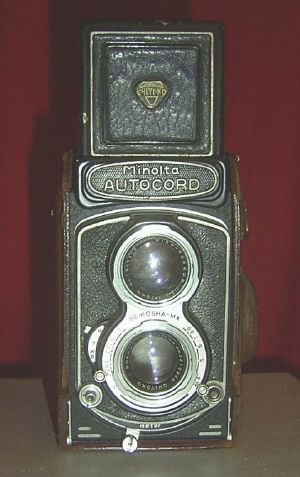
In 1934, the company released the Minolta Vest, originally designed by Ehira Nobujirō, with an innovative system of collapsible boxes replacing the bellows. In 1936, the company created the subsidiary Nippon Kōgaku Kikai Kenkyūjo (日本光学機械研究所, “Japanese Opto-mechanical Research Institute”) in the city of Amagasaki (尼崎市), to manufacture bakelite cameras such as the Minolta Vest, Minolta Six and Baby Minolta. This subsidiary was soon merged into the main company, and became its Amagasaki plant. In February 1937, the company opened a third plant in the city of Sakai (堺市), in the Osaka prefecture.[6] In September 1937, the company became Chiyoda Kōgaku Seikō K.K. (千代田光学精工㈱, “Chiyoda Optics and Precision Industry Co., Ltd”.), abbreviated "Chiyoko" (千代光) on some logos and publications.[7], and introduced several expensive advanced cameras, including the first Japanese-made twin-lens reflex camera, the Minoltaflex, based on the German Rolleiflex. The Auto Semi Minolta was the first serially-produced Japanese camera with a combined range- and viewfinder; the Auto Press Minolta, an evolution of the Makina copy, was the first Japanese camera synchronized for flash; and the Minolta Flex was the second Japanese 6×6 TLR.[8] In 1939, a fourth plant specializing in machine tools opened in Komatsu (小松).
World War II
Chiyoda began manufacturing its own Rokkor lenses in 1940, exclusively for military use.[9] It also produced military ordnance, including hand-held cameras for aerial reconnaissance. In 1942, the Japanese Imperial Navy asked the company to open a glass melting facility; the plant was built in Itami and was not operational until 1944. All five Chiyoda plants ended up participating to the war effort. Civilian camera production was stopped around 1943, and the company took over Fujimoto's plant in the city of Nishinomiya (the former Neumann & Heilemann factory), which became Chiyoda's Nishinomiya (西宮) plant.[10] The Mukogawa, Amagasaki and Komatsu (小松) plants were destroyed by aerial bombing.
Postwar period
The company resumed camera production shortly after the war with the Semi Minolta III. This camera was equipped with a Rokkor 75/3.5, the first commercially-available Japanese coated lens. The company also absorbed the optical section of the Toyokawa Navy Arsenal (Aichi prefecture), which became the Toyokawa (豊川) plant in November 1946.[11]
In 1950, Chiyoda released the Konan-16 Automat, a subminiature camera with its own 16mm film format. Throughout the 1950s, Chiyoda’s range consisted of TLR cameras, 4.5×6 folders, 35mm viewfinder and rangefinder cameras and 16mm subminiature cameras.
In 1954, Kazuo Tashima sent a mission to the United States to promote the sale of Japanese cameras there, the first such attempt by a Japanese camera manufacturer[12].
In the late 1950s and 1960s, Minolta competed in the medium-format rollfilm camera market with the excellent Autocord series of TLR (twin lens reflex) cameras. Marketed at a time when other indifferent copies of the Rolleiflex TLR design were flooding the market, the Autocords soon acquired an enviable reputation for the high quality of their Rokkor optics.
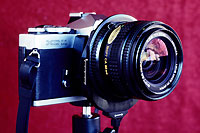
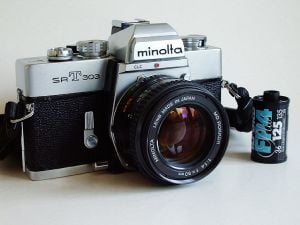
As a youth, Minolta's founder, Kazuo Tashima, had been fascinated by the night skies. By the late 1950s, industrial pollution and light pollution had obscured the stars for many urban dwellers, and Tashima resolved to recreate the experience of stargazing by using technology.[13] In 1958, Chiyoda produced its first planetarium projection apparatus[14].
Introduction of the SLR
Minolta adopted the strategy of producing a reasonably-priced camera that would allow ordinary people without much skill or experience to take professional-quality photos. Until that time, only two types of camera had been available: expensive and sophisticated professional cameras, and cheap, low-quality cameras for amateurs. In 1958, Minolta it introduced the SR-2, its first 35mm SLR(single-lens reflex) camera, and one of the first to combine several features of the modern SLR, such as a pentaprism viewfinder, instant-return mirror, bayonet mount lenses, lever advance and auto-resetting frame counter. The new SLR cameras began a worldwide revolution in amateur photography.
In 1959 Chiyoda began producing photocomposing machines, copiers, and special projectors. In 1962, the company name became Minolta Camera K.K. (ミノルタカメラ㈱, meaning Minolta Camera Co.). In 1964 Minolta began the production of versatile and sensitive light meters. The Minolta SR-T series of SLR cameras introduced in 1966 was a big success and the Minolta SR-T 101 was one of the world's best-selling cameras of its type.
The SR-T 35mm SLR camera series (cameras with the 'SR' designation equipped with through-the-lens metering) are regarded as some of the most innovative single lens reflex (SLR) cameras of the era. Although well-made, the SR series and the SR-T series were not as robust as the professional-level Nikon F or F2. Like the Canon Ftb, the Minolta SR/SRT design used sleeve bushings instead of bearings on its focal plane spindles, and had greater tolerances between working parts. This occasionally caused problems in very cold weather or at extremely high-levels of use. Nevertheless, the cameras appealed to serious amateur photographers with their more affordable prices and high-quality optics.
John Glenn took a Minolta Hi-Matic rangefinder 35 mm camera aboard the spacecraft Friendship 7 in 1962, and in 1968, Apollo 8 orbited the moon with a Minolta Space Meter aboard.
From the late 1950s through the 1980s, Minolta introduced one innovation after another; it was the first Japanese manufacturer to introduce a bayonet lens mount rather than a screw mount, the first manufacturer to introduce TTL metering with full aperture, and the first manufacturer to introduce multi-mode metering. With the Maxxum series, Minolta also introduced the first commercially-successful autofocus SLR line.
Cooperation with Leitz
In June, 1972, Minolta signed a cooperation agreement with the German camera company Leitz , entering a new phase of cooperation with German experts.[15]Leitz needed expertise in camera body electronics, and Minolta felt that they could learn from Leitz's undoubted optical expertise.
The first results of this collaboration appeared in 1974: the Minolta XE SLR and the Leica CL rangefinder camera (sold in Japan as the Leitz Minolta CL). The XE was the basis for the 1977 Leica R3. The final product of Minolta’s association with Leitz was the Minolta XD-11 (the same as XD-7, and the basis of the Leica R4), the first multi-mode 35mm compact SLR camera combining both aperture priority and shutter priority automatic exposure modes in a single body. Many Rokkor lenses of the new MD series, usable in both automatic modes, were produced for this exciting camera. The XD-11 is considered by many to be the best manual-focus 35mm SLR Minolta ever produced.
In 1981, Minolta launched the CLE, a rangefinder camera with M-mount, the first one to have (aperture-priority) automatic exposure, “TTL OTF” (through the lens, reflected off the film) metering and TTL flash automation. The same year, Minolta returned to the amateur market with the X-700 SLR. Minolta continued to offer 35mm MF SLR cameras in its X370, X-570, and X-700 from 1981, but slowly repositioned its cameras to appeal to a broader market, abandoning the high level of design and parts specification of its earlier XD/XE line. The advanced vertical metal shutter design of the older cameras was rejected in favor of a cheaper horizontal cloth-curtain shutter, reducing flash sync to a very slow 1/60th second. Further cost savings were realized by changing some interior operating components from metal to plastic. Minolta decided to invest in a new autofocus SLR design, and to withdraw from building professional-level manual-focus SLR cameras. In 1981, Minolta X-700 single lens reflex camera becomes the first winner of the "European Camera of the Year." In 1982, Kazuo Tashima stepped down as president of the company, and was succeeded by his son, Hideo Tashima. Kazuo Tashima remained Chairman of the Board until his death in 1985, at the age of 85.
The Nishinomiya plant, which hosted research and development activities as well as a service center, was closed in April 1985.
Automation
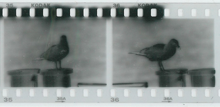
In 1985, the Minolta 7000 AF SLR, the world's first "in-body" autofocus SLR camera, was introduced. Previously, manufacturers had experimented with lenses that focused themselves but that fitted their existing, manual-focus SLR cameras. Minolta was the first manufacturer to put the mechanism and electronics for the autofocus system into its SLR camera bodies.[16] The Maxxum 7000 had two 8-bit CPUs and six integrated circuits. A circuit on the lens relayed aperture information to the camera body, and the motor for autofocus was contained within the camera body. An LCD showed aperture, shutter speed and film frame count. The 7000 had TTL phase-detection focusing and metering, autoexposure and predictive autofocus. The Maxxum 7000, the most popular of the new Maxxums, introduced the innovation of arrow buttons for setting aperture and shutter speed, rather than a shutter speed dial on the body and an aperture ring on the lens. The camera had an advanced design, with liquid crystal screen display, built-in film winder, and a body built largely of plastics.
In North America, Minolta used the name Maxxum, in Europe the cameras were called Dynax and in Japan they were named Alpha. For five years beginning in 1985, Minolta was the leading seller of SLR cameras in the world, until Canon and Nikon introduced new autofocus designs of their own, with a wide array of new lenses and professional bodies. Minolta concentrated on the affordable end of the SLR market, and pursued revolutionary technological developments.
After popularizing the plastic-bodied, push-button-controlled SLR, in the mid 1990s, the company returned to a more traditional user interface with the 600si Classic. This interface was carried forward into its popular pro-level Minolta Alpha/Dynax/Maxxum 9 and later, the Maxxum 7.
Unfortunately, Minolta’s autofocus design was found to infringe on the patents of Honeywell, a U.S. corporation. After protracted litigation, Minolta in 1991 was ordered to pay Honeywell damages, penalties, trial costs and other expenses in a final amount of 127.6 million dollars.
Though well received by the photographic press, the Maxxum (Dynax) 9 and the Maxxum 7 in 2000, which used a full LCD readout on the rear of the camera, did not achieve expected sales. All of these cameras were eventually discontinued in favor of the less-expensive Maxxum 50 and 70, which were sold under the Minolta name until 2006.
Like other camera manufacturers, Minolta faced difficulties in building low-priced cameras for the amateur consumer market. It was one of the first Japanese companies to move production of its cameras to Malaysia, China, and other countries with less expensive labor. Minolta occasionally redesigned parts in existing models with less expensive materials, or introduced new, less expensive designs, in an effort to cut costs. Even in times of financial crisis, Minolta refused to become a subcontractor and continued to strive for innovation.
Minolta also invested heavily in APS (Advanced Photo System) film-format cameras, most notably with the Vectis line of SLR cameras beginning in 1996. APS cameras did not sell as hoped. Digital photography was entering the marketplace, and Minolta eventually discontinued all APS camera production.
Innovative features
Minolta introduced a number of features that became standard in all brands a few years later. Among standardized features that were first introduced on Minolta models are: multisensor light-metering coupled to multiple AF-sensors; automatic flash balance system; wireless TTL flash control; TTL controlled full-time flash sync; and speedy front and rear wheels for shutter and aperture control. Special features introduced by Minolta are: interactive LCD viewfinder display; setup memory; expansion program cards (discontinued); eye-activated startup; and an infrared frame counter.
Digital cameras
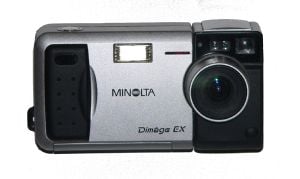
Minolta began offering consumer-level digital cameras in the late 1990s, creating a new category of 'ZSLR' or fixed zoom-lens SLR-type cameras with the introduction of the DiMage 7. The DiMage incorporated many of the features of a higher level film camera with the simplicity of smaller compact digital cameras. The camera had a traditional zoom ring and focus ring on the lens barrel, and was equipped with an electronic (EVF) viewfinder rather than the direct optical reflex view of an SLR. Minolta solved the problem of the protruding optical zoom lens on pocket digital cameras, with a folded lens design that allowed an optical zoom lens to be totally contained within the body of the camera. It added other features such as a histogram and the cameras were compatible with Minolta's flashes for modern film SLRs.
Minolta later innovated this line by being the first manufacturer to integrate a mechanical anti-shake system based inside the camera body.
Merger with Konica
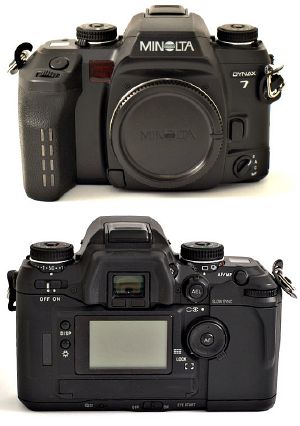
In October, 2003, in an effort to strengthen market share and acquire additional assets in film, film cameras and optical equipment, Minolta merged with Konica to form Konica Minolta. All new cameras after that time were branded as Konica Minolta, although Minolta remained the dominant partner in design and development.
Minolta has been criticized for its slowness to bring out a digital SLR camera compatible with the Dynax/Alpha-mount lenses. In late November 2004, Konica Minolta released the much anticipated Konica Minolta Alpha/Dynax/Maxxum 7D Digital SLR. The 7D DSLR had built-in image stabilization which worked with any electronic autofocus lens attached to the camera body.
During July 2005, [17] Konica Minolta and Sony negotiated on a joint-development of a new line of DSLR cameras On January 19, 2006, Konica Minolta announced that it was leaving the camera and photo business[18]and that it would sell the digital portion of its SLR camera business to Sony as part of its move.[19] In the spring of 2006, Konica Minolta ceased the production of film cameras and is now solely a manufacturer of office machines.
Sony announced the first Konica-Minolta-based Sony SLR - the Alpha A100 - on June 5, 2006.
Company name
Nichidoku Shashinki Shōten (日独写真機商店, “Japan-German Camera Store”), the precursor of Minolta, was founded in Osaka on November 11, 1928, in collaboration with two German engineers. In 1931 the company was reorganized as a joint-stock corporation named Molta Gōshi-gaisha (モルタ合資会社), taken from the German "Mechanismus Optik und Linsen von Tashima" ("Mechanism, Optics and Lenses by Tashima").[20] The name Minolta was applied for and registered in 1933,[21] and it was first used for a camera called simply “Minolta,” a copy of the Plaubel Makina I. Many sources say that the name was crafted from "Mechanismus, Instrumente, Optik und Linsen von Tashima" ("Mechanism, Instruments, Optics and Lenses by Tashima") but it is more likely inspired by the Japanese word minoru ta (稔る田), "ripening rice-fields" (a strong image of health and fruitfulness in Japan, and in Japanese pronounced identically to "Minolta"), in combination with the name "Molta" itself.[22] All the later model names included the word "Minolta," but the company name and brand name differed until 1962.
Timeline
- 1928: Kazuo Tajima establishes Nichi-Doku Shashinki Shōten (Japanese-German photo company; the precursor of Minolta Co., Ltd.).
- 1929: Markets the Company's first camera, the "Nifcalette."
- 1937: The "Minolta Flex" is Japan's first twin-lens reflex camera.
- 1958: The Minolta SR-2 is Minolta's first single-lens reflex camera.
- 1959: The Minolta SR-1.
- 1960: Release of its first copier, the Copymaster.
- 1962: John Glenn takes a specially modified Ansco-logo'd Minolta Hi-Matic camera into space aboard Freedom 7. The company changes its name to Minolta Camera Co., Ltd.
- 1966: The Minolta SR-T 101 SLR camera is Minolta's first with through-the-lens full aperture (TTL) light metering.
- 1972: Minolta signs an agreement to cooperate with Leica in SLR development.
- 1973: The first result of the collaboration with Leica, the Minolta CL, is released.
- 1976: The Leica R3 is introduced. Minolta produces the R3, R4, and R5 models in the Leica R series. Subsequent cameras are built in Germany by Leica themselves.
- 1981: Implementation of Minolta's invention and patent of TTL OTF Through The Lens Off The Film exposure metering: The Minolta CLE is the first 35 mm rangefinder camera to feature TTL metering and aperture priority auto-exposure. The Minolta X-700 manual-focus SLR is introduced; this model is sold until 1999 and is enormously successful. The Minolta XD-11 (Model E) is the first Minolta product branded with an updated logo in caps, which was in use until the 2003 merger with Konica.
- 1985: The Minolta Maxxum 7000 becomes the world's first truly successful autofocus SLR. Other manufacturers soon follow suit.
- 1987: Honeywell files a lawsuit against Minolta for patent infringement over autofocus technologies.
- 1991: Minolta's innovative autofocus design is found to infringe on the patents of Honeywell, a U.S. corporation. After protracted litigation, Minolta is ordered to pay Honeywell damages, penalties, trial costs and other expenses amount to 127.6 million dollars.
- 1992: Minolta finally settles out-of-court with Honeywell.
- 1994: The company changes its name to Minolta Co., Ltd. because it no longer is primarily a camera company.
- 1995: Introduction of the Minolta RD-175, an early 1.75 megapixel digital SLR camera.
- 1996: The Minolta Vectis camera is a completely new SLR system designed around the Advanced Photo System (APS) film format.
- 1998: The Minolta Maxxum 9 autofocus SLR is introduced. This system is targeted toward the professional photographer and has many features not duplicated by the competition.
- 2003: DiMAGE A1 introduced, replacing the DiMAGE 7HI. DiMAGE A1 final Minolta product branded prior to the Konica Minolta merger.
- 2004: Minolta and Konica officially merge to become Konica-Minolta Holdings, Inc.
- 2005: The company announces joint venture with Sony on CCD and CMOS technologies.
- 2006: Konica-Minolta announces it is discontinuing all film and digital camera production, ending a 78-year history as a camera manufacturer. Konica-Minolta Photo Image, Inc.'s (the camera business portion of Konica Minolta) asset regarding digital camera technology is transferred to Sony for continued development started from the joint venture.
Notes
- ↑ Date: Kazuo Tashima, Watakushi no rirekisho, quoted in Yoshihiko Tanimura (谷村吉彦), Kurashikku Kamera Senka no. 12: 96. The address of the company in the early 1930s was Ōsaka-shi Higashi-ku Kita-kyūtarō-machi 3-chōme 15-banchi Mishina Building (大阪市東区北久太郎町三丁目十五番地三品ビルヂング内). Sources: advertisements dated 1930 to 1932 reproduced in Hagiya, of Kurashikku Kamera Senka no. 12: 9, see trademark publication no.S08-004434 for the name "MINOLTA" (ミノルタ), dated 1933, available in the IPDL trademark database, and patent for the Crown E shutter dated 1934, reproduced in Tanimura, Camera Collectors' News no. 131: 5–7, and Minolta, Camerapedia.org. Retrieved May 25, 2008
- ↑ Tashima, Watakushi no rirekisho, quoted in Andō, Camera Collectors' News no. 127: 2. The dates are repeated in Tanimura, Kurashikku Kamera Senka no. 12: 96, and Mikio Awano (粟野幹男), Kurashikku Kamera Senka no. 12: 6, and Minolta, 1 Camerapedia.org. Retrieved May 25, 2008
- ↑ Dates and company name: Tanimura, Kurashikku Kamera Senka no. 12: 96. The company name is confirmed by an extract of the Kōbe Shinbun (September 27, 1937): reproduced on Kōbe Shinbun (September 27, 1937): 99. Minolta, Camerapedia.org. Retrieved May 25, 2008
- ↑ Tanimura, Kurashikku Kamera Senka no.12: 97. Minolta, Camerapedia.org. Retrieved May 25, 2008
- ↑ All the advertisements for the Minolta or Happy cameras from the mid-1930s to 1945 were placed by Asanuma. Minolta, Camerapedia.org. Retrieved May 25, 2008
- ↑ Sakai, Kurashikku Kamera Senka no.12: 7, Francesch, Dominique and Jean-Paul. Histoire de l'appareil photographique Minolta de 1929 à 1985. (Paris: Dessain et Tolra, 1985. ISBN 2249276854), 23. Minolta, Camerapedia.org. Retrieved May 25, 2008
- ↑ Date: Awano, Krashikku Kamera Senka no.12: 7, and Francesch, 25.
- ↑ The first Japanese 6×6 TLR was the Prince Flex.
- ↑ Date: Hiroshi Ema (江間宏), Kurashikku Kamera Senka no.12: 90. Minolta, Camerapedia.org. Retrieved May 25, 2008
- ↑ Tanimura, Kurashikku Kamera Senka no.12: 99. Minolta, Camerapedia.org. Retrieved May 25, 2008
- ↑ Optical section of the Toyokawa Navy Arsenal: Awano, Kurashikku Kamera Senka no. 12: 7. ; Date: Francesch, 29 Minolta, Camerapedia.org. Retrieved May 25, 2008
- ↑ New York Times Kazuo Tashima, 85, Is Dead; Founder of Minolta Company (November 23, 1985) Retrieved June 24, 2008
- ↑ Sam Kusumoto and Edmund P. Murray. 1989. My bridge to America: discovering the new world for Minolta. (New York: Dutton. ISBN 0525247874)
- ↑ Corporate profile of Konica Minolta Planetarium Co., Ltd. The first planetarium apparatus made in Japan was made by Gotō Kōgaku: see the history page of Goto Inc.
- ↑ Date: Francesch, 179. Minolta, Camerapedia.org. Retrieved May 25, 2008
- ↑ Konica had been the first to put autofocus into a 35mm camera, but it was a fixed lens "compact" camera; and Polaroid had been the first to put autofocus into an SLR camera, but it neither was 35mm nor was an interchangeable lens design.
- ↑ Konica Minolta and Sony Agree to Jointly Develop Digital SLR Cameras, KonicaMinolta.com. July 19, 2005. Retrieved May 26, 2008.
- ↑ Konica Minolta Announces Withdrawal Plan for Camera Business and Photo Business, konicaminolta.com January 19, 2006. Retrieved May 26, 2008.
- ↑ Partial Transfer of Certain Assets Related to Digital SLR cameras, konicaminolta.com, January 19, 2006. Retrieved May 26, 2008.
- ↑ Tanimura, Kurashikku Kamera Senka no. 12: 97. Minolta, Camerapedia.org. Retrieved May 25, 2008
- ↑ Trademark publication (商標広告) no.S08-004434, for the name "MINOLTA" (ミノルタ), available in the IPDL trademark database, and trademark registration no.0246579 available in the English-language IPDL trademark database
- ↑ The etymology minoru ta (稔る田) is mentioned in Taniguchi, Shashin Kōgyō no. 77: 276, (article also reproduced in Tanimura, Camera Collectors' News no. 116: 8). Minolta, Camerapedia.org. Retrieved May 25, 2008
References
ISBN links support NWE through referral fees
- Asahi Camera (アサヒカメラ) editorial staff. 1994. Shōwa 10–40nen kōkoku ni miru kokusan kamera no rekishi (昭和10〜40年広告にみる国産カメラの歴史, Japanese camera history as seen in advertisements, 1935–1965). Tokyo: Asahi Shinbunsha. ISBN 4023303127.
- Awano Mikio (粟野幹男). "Minoruta ryakushi" (ミノルタ略史, Minolta short history). Kamera Rebyū: Kurashikku Kamera Senka (カメラレビュー クラシックカメラ専科) / Camera Review: All about Historical Cameras no. 12 (October 1988): 6–8. Minoruta kamera no subete (ミノルタカメラのすべて, special issue on Minolta).
- Ema Hiroshi (江間宏). "Rokkōru renzu no hanashi" (ロッコールレンズの話, Rokkor lens stories). Kamera Rebyū: Kurashikku Kamera Senka (カメラレビュー クラシックカメラ専科) / Camera Review: All about Historical Cameras no. 12 (October 1988): 90–93. Minoruta kamera no subete (ミノルタカメラのすべて, special issue on Minolta).
- Francesch, Dominique and Jean-Paul. 1985. Histoire de l'appareil photographique Minolta de 1929 à 1985. Paris: Dessain et Tolra. ISBN 2249276854. (in French)
- Hagiya Takeshi (萩谷剛). "Kōkoku ni miru Minoruta kamera no rekishi" (広告に見るミノルタカメラの歴史, Minolta camera history seen through the advertisements). Kamera Rebyū: Kurashikku Kamera Senka (カメラレビュー クラシックカメラ専科) / Camera Review: All about Historical Cameras no. 12 (October 1988): 9–12. Minoruta kamera no subete (ミノルタカメラのすべて, special issue on Minolta).
- Kusumoto, Sam and Edmund P. Murray. 1989. My bridge to America: discovering the new world for Minolta. New York: Dutton. ISBN 0525247874.
- McKeown, James M. and Joan C. 2004. McKeown's Price Guide to Antique and Classic Cameras, 12th Edition, 2005-2006. USA, Centennial Photo Service. ISBN 0931838401.
- Nakagawa Chū (中川忠). "Metaru fōkaru purēn shattā no hensen (dai-ikkai)" (メタルフォーカルプレーンシャッターの変遷[第1回], Evolution of the metal focal-plane shutter [part 1]). Kamera Rebyū: Kurashikku Kamera Senka (カメラレビュー クラシックカメラ専科) / Camera Review: All about Historical Cameras 51 (June 1999): 118–122. ISBN 4257130245. Kurashikku kamera supesharu (クラシックカメラスペシャル, issue about miscellaneous classic cameras).
- Scheibel, Anni Rita and Joseph. 70 Jahre Minolta Kameratechnik—Von der Nifcalette bis zur Dynax 9. Stuttgart: Lindemanns Verlag, 3rd edition, 1999. ISBN 3895061913.
- Taniguchi Masao (谷口匡男), from the commercial department (営業部) of Chiyoda Kōgaku Seikō. "Minoruta kamera no sakujitsu, konnichi" (ミノルタ・カメラの昨日、今日, Minolta cameras, yesterday and today). In Shashin Kōgyō 77 (September 1958): 275–279. (The two first pages of this document, on pre-1937 cameras, are also reproduced in Tanimura, Camera Collectors' News no.116: 8)
- Tanimura Yoshihiko (谷村吉彦). "Neumann & Heilemann: kieta ashiato, Minoruta setsuritsu to sono ato no karera wo otte" (Neumann & Heilemann 消えた足跡・ミノルタ設立とその後の彼等を追って, On the traces of Neumann & Heilemann at the founding of Minolta and afterwards.) Kamera Rebyū: Kurashikku Kamera Senka (カメラレビュー クラシックカメラ専科) / Camera Review: All about Historical Cameras no. 12 (October 1988): 96-99. No ISBN number. Minoruta kamera no subete (ミノルタカメラのすべて, special issue on Minolta).
- The article was written based upon Minolta, v. 59192, Camerapedia.
Credits
New World Encyclopedia writers and editors rewrote and completed the Wikipedia article in accordance with New World Encyclopedia standards. This article abides by terms of the Creative Commons CC-by-sa 3.0 License (CC-by-sa), which may be used and disseminated with proper attribution. Credit is due under the terms of this license that can reference both the New World Encyclopedia contributors and the selfless volunteer contributors of the Wikimedia Foundation. To cite this article click here for a list of acceptable citing formats.The history of earlier contributions by wikipedians is accessible to researchers here:
- Minolta history
The history of this article since it was imported to New World Encyclopedia:
- History of "Minolta"
Note: Some restrictions may apply to use of individual images which are separately licensed.
↧ Download as ZWI file | Last modified: 02/04/2023 05:07:19 | 21 views
☰ Source: https://www.newworldencyclopedia.org/entry/Minolta | License: CC BY-SA 3.0
 ZWI signed:
ZWI signed: KSF
KSF